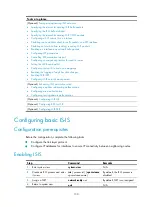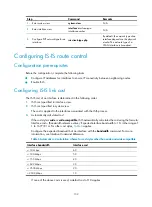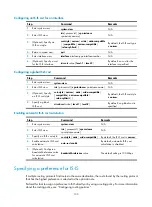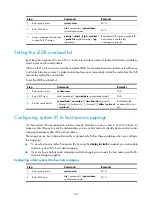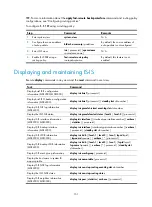
142
Enabling LSP fragment extension
Perform this task to enable IS-IS fragment extension for an IS-IS process. The MTUs of all interfaces
running the IS-IS process must not be less than 512. Otherwise, LSP fragment extension does not take
effect.
To enable LSP fragment extension:
Step Command
Remarks
1.
Enter system view.
system-view
N/A
2.
Enter IS-IS view.
isis
[
process-id
] [
vpn-instance
vpn-instance-name
]
N/A
3.
Enable LSP fragment
extension.
lsp-fragments-extend
[
level-1
|
level-1-2
|
level-2
]
By default, this feature is disabled.
4.
Configure a virtual system
ID.
virtual-system
virtual-system-id
By default, no virtual system ID is
configured.
Configure at least one virtual system to
generate extended LSP fragments.
Limiting LSP flooding
In NBMA networks such as ATM and FR, many P2P links exist. As shown in
, Routers A, B, C
and D run IS-IS. When Router A generates an LSP, it floods the LSP out of Ethernet 1/1, Ethernet 1/2 and
Ethernet 1/3. After Router D receives the LSP from Ethernet 1/3, it floods it out of Ethernet 1/1 and
Ethernet 1/2 to Router B and Router C. However, Router B and Router C have already received the LSP
from Router A. Repeated LSP flooding consumes extra bandwidth.
Figure 38
Network diagram of a fully meshed network
To avoid this problem, you can add interfaces to a mesh group or block some interfaces.
•
An interface in a mesh group floods a received LSP only to interfaces not in the mesh group.
•
A blocked interface sends LSPs only after receiving LSP requests.
Before you configure this task, you must consider redundancy for interfaces in case LSP packets cannot
be flooded because of link failures.
To add an interface to a mesh group or block an interface:
Eth1/1
Eth1/2
Eth1/3
Eth1/1
Eth1/1
Eth1/2
Eth1/3
Eth1/1
Eth1/2
Eth1/3
Eth1/2
Eth1/3
Router A
Router B
Router C
Router D



